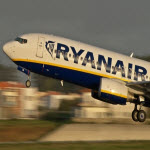New Law May Change Ryanair Limit On Passengers With Disabilities
- Written by Roberto Castiglioni
 Low cost carrier Ryanair imposes a controversial limit of four passengers with disabilities per flight; however things may change as a new EU law comes into effect in 2014.
Low cost carrier Ryanair imposes a controversial limit of four passengers with disabilities per flight; however things may change as a new EU law comes into effect in 2014.
Ryanair claimed the limit was imposed to guarantee the safety of passengers with disabilities on board, limiting the number of passengers with reduced mobility to the number of cabin crew. However, many believe the limit was imposed to ensure faster "turnaround", the time needed by ground handlers for loading, unloading, and servicing an aircraft. Currently Ryanair operates 20 minutes turnarounds, the shortest in the aviation industry,
The Irish low cost carrier maintained that the maximum of four passengers with disabilities were agreed and put in place in 1995 after discussions with the Irish Wheelchair Association in Ireland and the Royal Association for Disability and Rehabilitation (RADAR) in the UK. However, both the DRC and Mr Massie denied providing guidance to Ryanair on limits to the numbers of disabled passengers able to board flights.
The Irish Civil Aviation Authority also said that it is the air carrier's choice to impose such limits. “The IAA enforces European law with regard to passenger seating," Claire O’ Donoghue, Senior Aviation Executive at the Irish Aviation Authority, said. “The restriction on seating certain categories of passengers at bulkhead rows is entirely driven by operator preference when compiling emergency procedures. There is nothing specific in the legislation which determines this.” At the time of certifying Ryanair Operations Manual, the IAA simply acknowledged the limit.
EU Regulation 965/2012, which came into force in October 2012, but will apply to European operators at the latest 2 years after this date, may force Ryanair to abandon the discriminatory limit. The key change in the new regulation is that the National Civil Aviation Authority will have to approve, not just acknowledge, airlines certification materials.
Its predecessor, EU Regulation 859/2008 does not establish a limit of PRMs per flight. "Guidance Material has been interpreted differently by European National Authorities," a spokesperson for EASA, the European Aviation Safety Agency, told Reduced Mobility Rights. "While some have advised their operators that a rigid limit of 4 or 2 PRMs on board would not be appropriate, other National authorities have not done so."
In the new regulation, AMC1 CAT.OP.MPA.155(b) lists four equally important factors that should be
The major change is that when the new Operations Manual will be submitted for approval, it will be up to the Civil Aviation Authority to approve them. "This means that the national authority will establish together with the operator and taking into account the factors mentioned above how the operator should comply with the relevant OPS rules. By approving the OM of the operator, the national authority will assess how the operator has transposed the applicable rules and regulations into its OM," the EASA spokesperson said.
Rules for carriage of special categories of passengers (SCPs) include passengers with
disabilities, infants and unaccompanied children, deportees and prisoners in custody. "Specific safety aspects/constraints may lead an operator to conclude that ensuring safe operation may require that the number of SCPs that can be carried on particular flight(s) needs to be smaller than the maximum number of SCPs, which should be less than the number of passengers capable of assisting," the EASA spokesperson added. "In any case, the operator will have to be appropriately reflecting this in its procedures, which, as already mentioned, will be assessed by the authority when approving the Operations Manual."
The vast majority of European airlines, including low cost carrier Easyjet, do not impose stricter limits. In the United States, airlines are banned from imposing any limit on carriage of passengers with disabilities.
Do you think Ryanair is right imposing the limit of four passengers with disabilities per flight? Do you think the Irish Aviation Authority should impose Ryanair to waive the current limit? Have your say.
About the author
Founder and Editor-in-Chief of Reduced Mobility Rights, Roberto Castiglioni is an expert consultant of PRM regulations and disabled passengers support procedures, and has personal experience as travelling partner and carer of a passenger with reduced mobility.
Roberto is a member of the UK Civil Aviation Authority Access To Air Travel Working Group. He is also a member of the Easyjet Special Assistance Advisory Group. Chaired by David Blunkett MP, the independent advisory group esaag provides Easyjet with strategic guidance and practical advice on the evolving needs of passengers requiring special assistance.










